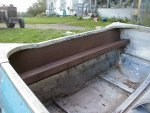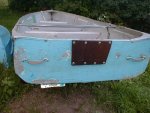My mother bought a 14 ft. aluminum boat in the early 60's. The plate is long gone, but I remember it was made by Traveller, and the model was "Corvair." It's a lightweight boat for its size, with the thinnest-gauge hull I've ever seen, and four aluminum seats. It has a vee hull, but as I am no expert I couldn't tell you if it is a semi-vee or deep-vee. My mother originally thought to use it as a cartopper, but it turned out to be just a bit too hard on the suspension of her '59 Chevy, so she bought a trailer. Two men, or three boys, can lift it onto the top of a car. My brothers and I did it when I was 13 and they were 10 and 11, but then we're farm boys and perhaps knew our strength better than others might.
The original plate had the maximum hp as 17, but when my father mounted a 15 on it once it bowed the transom back more than he liked. Of course, that was after the tree had fallen on it and flattened it, and we had it pounded back out, so the transom MAY have been weakened. After that we added a 2 x 4 that strengthened the transom a great deal, and a 9.5HP was fine on it for 20 years.
But this summer the transom board finally rotted to the point where it had to be replaced. I've replaced the original 1' plywood board with a piece of white oak, and replaced our 2 x 4 as well. To pull on it now, it feels stronger than it ever has.
At the same time, I have been given a '56 15HP Johnson outboard, which I have managed to bring back from the dead. I'd like to put the 15HP on this boat, and I think it'll take it now, but I think it would be a good idea to reduce the torque on the transom as much as possible without reducing performance. I have a Stingray Junior "hydrofin" mounted on my 9.5, mostly to give me better boat control at reduced speeds under windy, rough conditions. The boat tended to pick up at the bow and catch the wind at anything under 3/4 throttle with just me in it, and the fin kept it down for me. I'm wondering if the same effect would reduce the torque strain on the transom with the 15. It makes sense to me that it would, but then I'm no maritime engineer, either.
The original plate had the maximum hp as 17, but when my father mounted a 15 on it once it bowed the transom back more than he liked. Of course, that was after the tree had fallen on it and flattened it, and we had it pounded back out, so the transom MAY have been weakened. After that we added a 2 x 4 that strengthened the transom a great deal, and a 9.5HP was fine on it for 20 years.
But this summer the transom board finally rotted to the point where it had to be replaced. I've replaced the original 1' plywood board with a piece of white oak, and replaced our 2 x 4 as well. To pull on it now, it feels stronger than it ever has.
At the same time, I have been given a '56 15HP Johnson outboard, which I have managed to bring back from the dead. I'd like to put the 15HP on this boat, and I think it'll take it now, but I think it would be a good idea to reduce the torque on the transom as much as possible without reducing performance. I have a Stingray Junior "hydrofin" mounted on my 9.5, mostly to give me better boat control at reduced speeds under windy, rough conditions. The boat tended to pick up at the bow and catch the wind at anything under 3/4 throttle with just me in it, and the fin kept it down for me. I'm wondering if the same effect would reduce the torque strain on the transom with the 15. It makes sense to me that it would, but then I'm no maritime engineer, either.





















